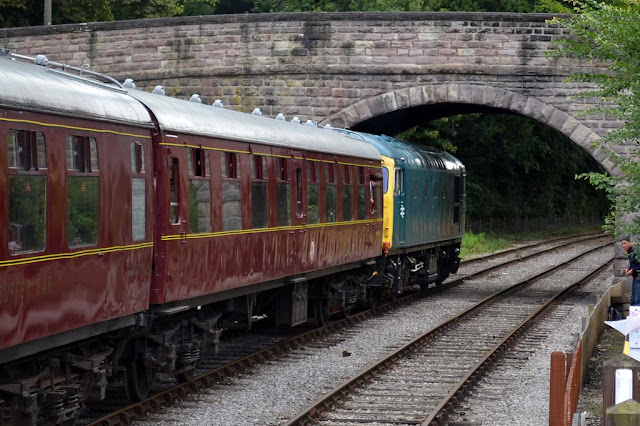 |
| EMU (Class 491), DMU (101) and locomotive (33) at Wirksworth |
| Information | |
|---|---|
| Type: | Preserved Railway (Ecclesbourne Valley Railway) |
| Station code: | WIR |
| Opened: | 1867 (Closed 1947) |
| Re-Opened: | 2002 |
| Platforms: | 3 |
The station was opened by the Midland Railway in 1867 as the terminus of a branch line from Duffield. Stone quarry traffic was the major source of traffic on the line (the station was linked to one such quarry via a tunnel under the town of Wirksworth itself [1]) with just three return trips a day to Derby the usual level service [2]. Passenger services ceased as early as 1947. The line remained open for freight however until 1989, the original station being demolished in 1968 [3] to allow for the expansion of freight facilities.
The line was taken over by a preservation society in 1998 with the first train running from a re-opened Wirksworth station in 2002 [4]. This train only went eight hundred metres to Gorsey Bank but the line was re-opened to the public in 2004 [5]. During the following years the line was gradually re-opened with services finally running through to Duffield in 2011. A short branch line to Ravenstor has also been opened from Wirksworth.
Wirksworth is the main base of the Ecclesbourne Valley Railway and is where maintenance facilities and main stock storage is located. The station has three platforms though in normal operation only platform two is used by service trains from Duffield. Platform one is usually used for stock storage. Trains to Ravenstor use platform three. Expanded station facilities are being built including a new main station building.
 |
| A visiting W&M railcar prepares to depart |
 |
| A Class 26 hauled train departs Wirksworth |
 |
| A steam hauled service arrives |
 |
| A former Gatwick Express set (489 and 488) used as a station buffet |
 |
| Wirkworth yard |
[1] Vic Mitchell & Keith Smith, Branch Lines to Wirksworth (Middleton Press, 2017) Map. VI
[2] Tom Tait & Neil Ferguson-Lee, The Ecclesbourne Valley Railway: the First 150 Years (Ecclesbourne Valley Railway Media ) p. 2
[3] Mitchell & Smith. Fig. 65
[4] Mitchell & Smith. Fig. 77
[5] Tait & Ferguson-Lee, p. 8






























